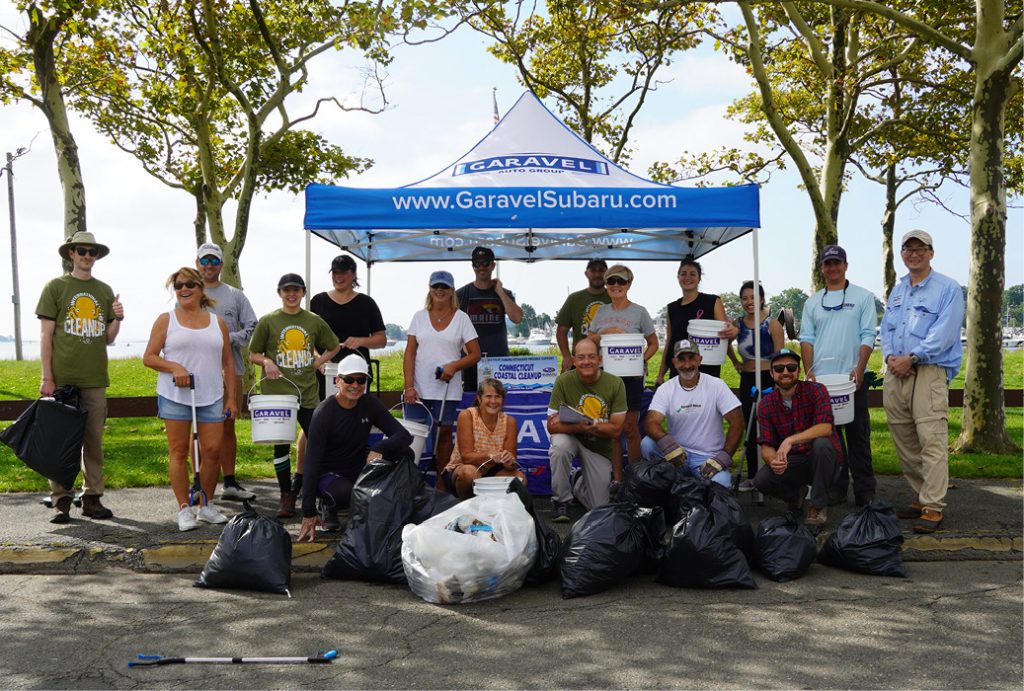By Anthony Allen, Save the Sound Assistant Director of Ecological Restoration
After the exceptional challenges of the annual Connecticut Coastal Cleanup in 2020, a record-breaking 2021 cleanup season brought a welcome dose of energy and reason for hope. The statewide cleanup effort, coordinated by Save the Sound and led by volunteers each year since 2002, held a limited number of in-person events and pivoted to a hybrid model that included “virtual” cleanups in 2020. The volunteers came through, only to find that single-use plastics were more a part of the landscapes they loved than in years past. We all ended the year hoping that the next Connecticut Cleanup would bring more opportunity for group cleanups and less plastics.

Connecticut Coastal Cleanup volunteers at Veteran’s Memorial Park and Marina in Norwalk, CT. © SavetheSound.org
2021 delivered. It may seem a distant memory, but the summer and fall of last year were the closest we’ve come to a respite from COVID. Cases were low, vaccinations were rising, and we gathered once again to clean up the beaches, parks, and riverbanks of Connecticut. In those conditions, and with the continued support of official sponsor Subaru of New England, Save the Sound coordinated a record 76 in-person cleanup events, with nearly 2,400 volunteers collecting more than 4 tons of trash. The data on plastics was also generally favorable in 2021, with several categories of plastic waste declining from the prior year, according to trends analysis* performed using Save the Sound data.
Categories that saw huge spikes in 2020, perhaps as a result of lifestyle shifts from retail to e-commerce and restaurant dining to take-out orders, dropped slightly but remained elevated in 2021. Strapping bands, commonly made of plastic and found around or inside packages, rose more than 120% from 2019 to 2020, but dropped by about 56% from 2020 to 2021. Plastic take-out containers, which spiked by more than 70% from pre-pandemic levels in 2020, similarly fell in 2021—but only by about 44%. While this data in no way implies causality, it seems to fit with the reopening of restaurants and retail statewide last year.
Plastic waste is Save the Sound’s primary focus during the Connecticut Coastal Cleanup each year, for good reason. Whether they enter our waterways through storm drains, on the wind, or as a result of carelessness, plastics that find their way into the environment are doomed to degrade and linger. As they break down into smaller and smaller pieces, plastics become harder to recover and easier for wildlife to ingest. From there, mounting evidence shows that the plastics we create, use, and dispose of find their way into our bodies.1
Small plastics are a big problem. In 2021, as in 2020, the most commonly recovered type of trash during the Connecticut Coastal Cleanup was tiny pieces of plastic (24,424). Cigarette butts, which are both plastic and filled with highly toxic chemicals, placed second (16,229).
One of the best tools we have to stem the tide of plastic waste in our waterways is policy-making to restrict or eliminate some of its uses. In Connecticut and New York, plastic bag fees and bans were implemented in recent years—Connecticut’s ban went into full effect on July 1, 2021—prohibiting retailers from providing single-use plastic bags at the point-of-sale. When the bag fee (the full ban was not yet in effect) was paused for COVID-19 in 2020, we saw an increase of nearly 50% in the incidence of plastic bags at Connecticut Cleanup sites. In 2021, with the ban in full effect, the combined total of all plastic bags recovered was down nearly 34% from 2020 to 2021. Again, these are correlations, and it is always risky to draw conclusions—but the findings do suggest a shift is occurring.
Save the Sound has made the reduction of plastic waste in our waterways one of the primary items on our 2022 CT legislative agenda. Among the legislation we will be supporting is an Extended Producer Responsibility Bill recently drafted by the Connecticut Department of Energy and Environmental Protection. If passed, this law would create incentives for consumers to return packaging containers and materials to manufacturers, enhancing the circular economy2 and preventing these single-use items from ending up in landfills or in the Sound. We are also one of several groups contributing to a Marine Debris Action Plan for Long Island Sound, being released this year, which features broad goals as well as specific strategies for removing plastics, abandoned fishing gear, and other debris from our waters.
We will continue to fight hard for the holistic management and reduction of single-use plastics in the halls of government, while simultaneously coordinating cleanups and installing green infrastructure to help capture it before it reaches our rivers and Long Island Sound. But we need your help. Join us this legislative session in fighting to turn off the tap on plastics! ■
* Trend analysis was performed on Save the Sound’s cleanup data from 2017-2021, and was adjusted for the number of cleanups held in each year.
1. Microplastics cause damage to human cells, study shows | Plastics | The Guardian
2. What is a Circular Economy? | US EPA



